Abstract
OBJECTIVE: The effect of insulin-like growth factor-1 (IGF-1) on energy expenditure and protein and glucose metabolism in a group of patients with thermal injury was determined. SUMMARY BACKGROUND DATA: Accelerated protein catabolism is a constant feature of the hypermetabolic response to thermal injury. Insulin-like growth factor-1 has been reported to minimize protein catabolism and normalize energy expenditure in animal models of thermal injury. METHODS: To determine the efficacy of IGF-1 in human burn patients, resting energy expenditure (metabolic cart), whole body protein kinetics (N15 Lysine), and glucose disposal (glucose tolerance test) were assessed in eight burn patients before and after a 3-day infusion of IGF-1 (20 micrograms/kg/hr). All patients were fluid-resuscitated uneventfully and were without obvious infection at the time of study. Enteral nutrition was administered at a constant rate before and during the IGF-1 infusion. RESULTS: Resting energy expenditure was not altered by IGF-1 (40.3 +/- 2.2 vs. 39.1 +/- 2.3 kcal/kg/day). However, glucose uptake was promoted, and protein oxidation decreased significantly (0.118 +/- 0.029 vs. 0.087 +/- 0.021 g/kg/d, p < 0.05) by IGF-1. In addition, insulin secretion, in response to a glucose challenge, was blunted. CONCLUSIONS: Insulin-like growth factor-1 therapy has a beneficial effect in preserving lean body mass during severe stress conditions by minimizing the flux of amino acids toward oxidation.
Full text
PDF
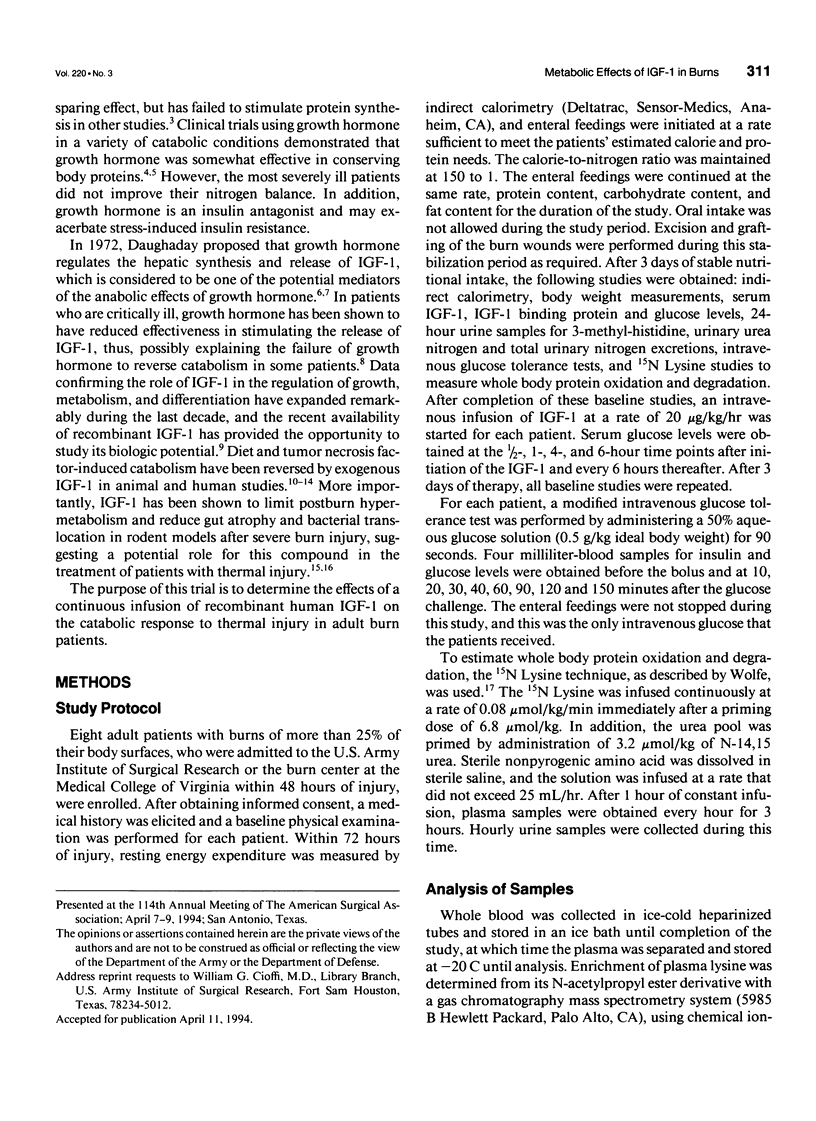
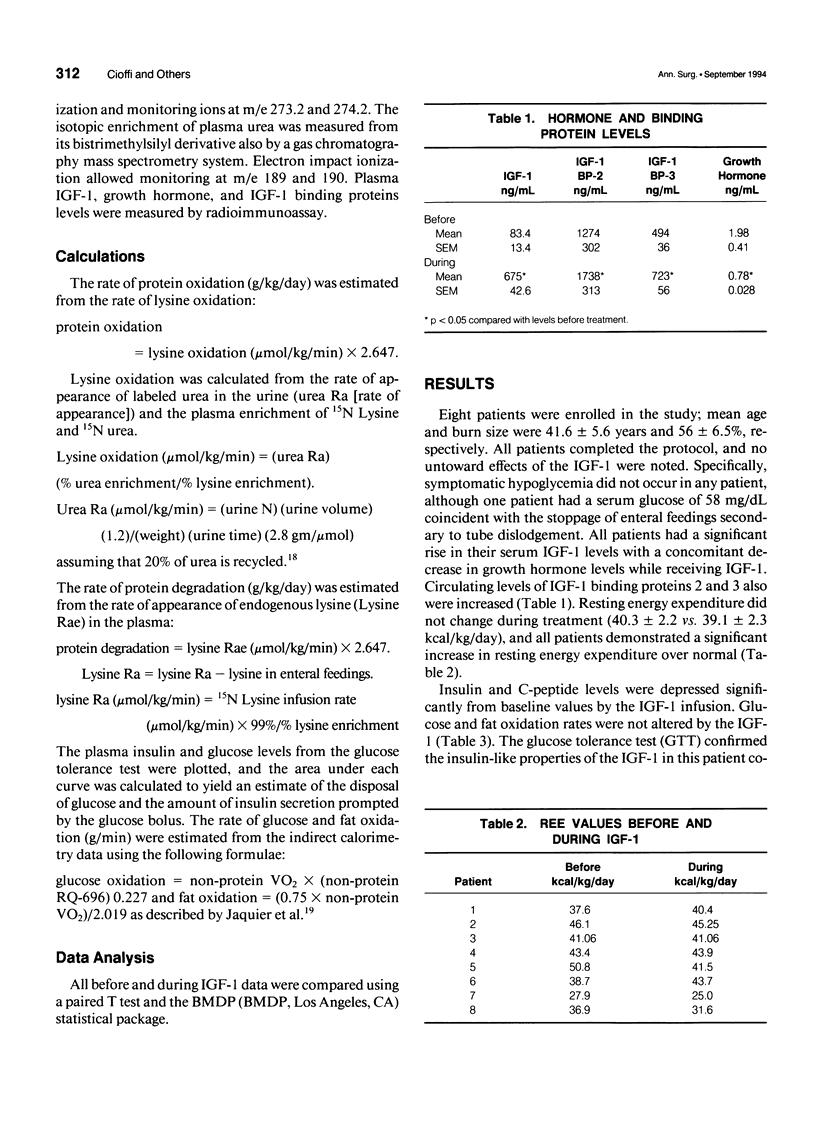
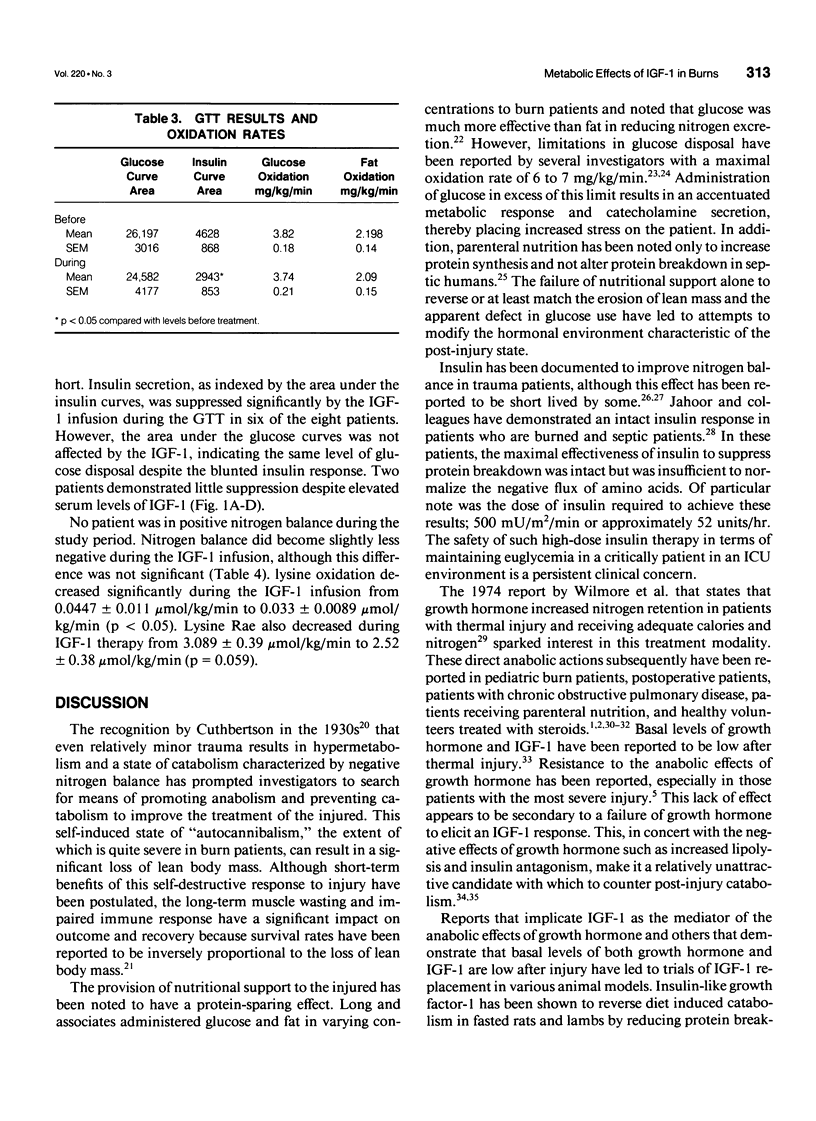
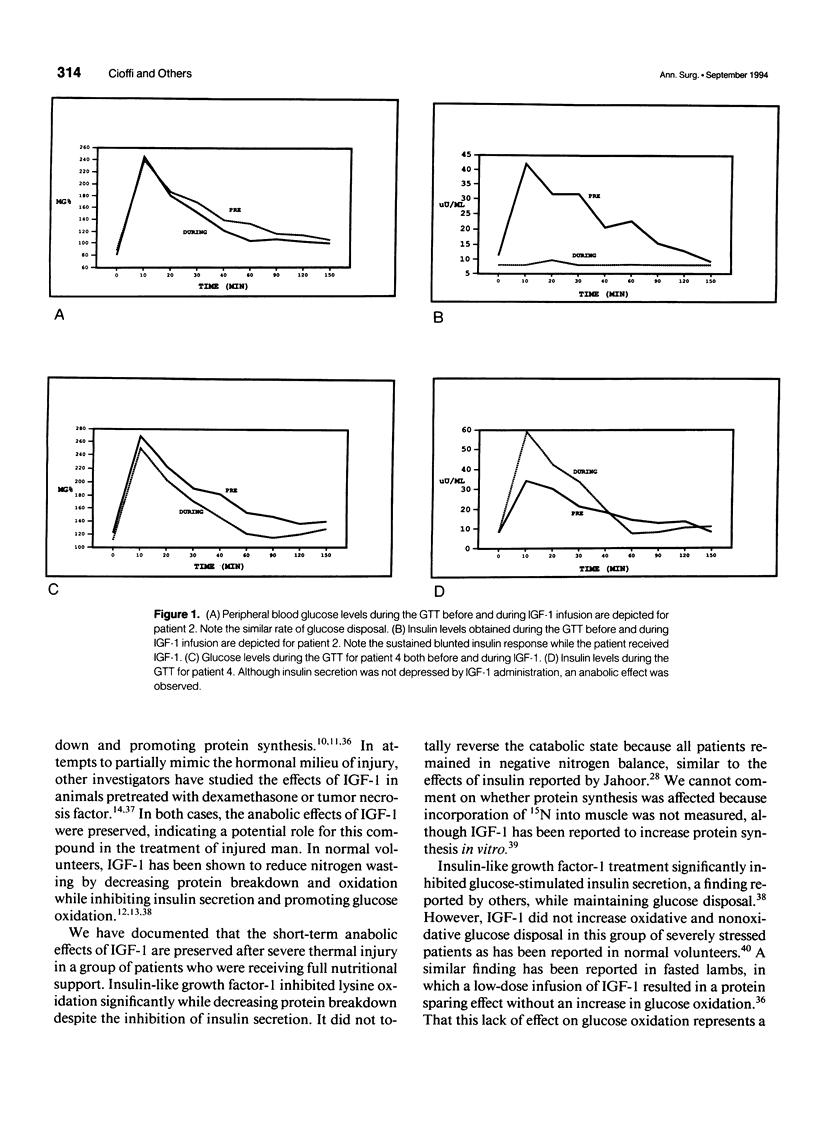
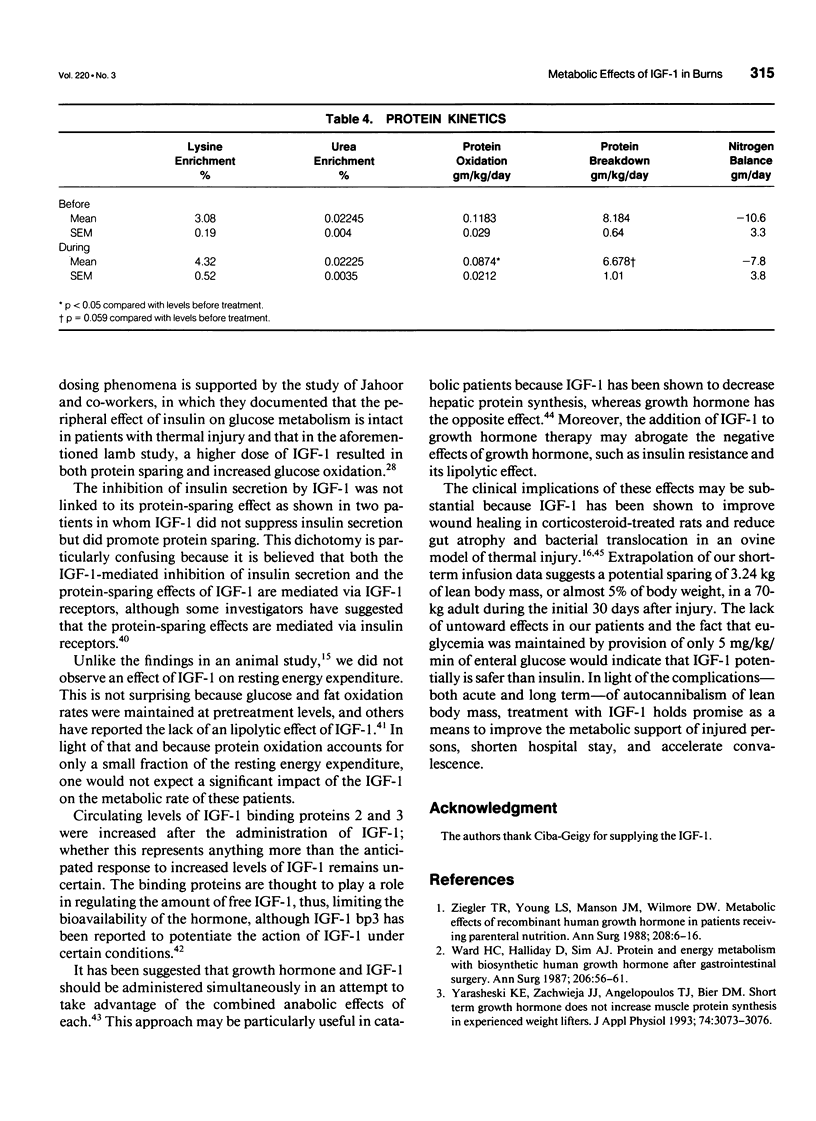
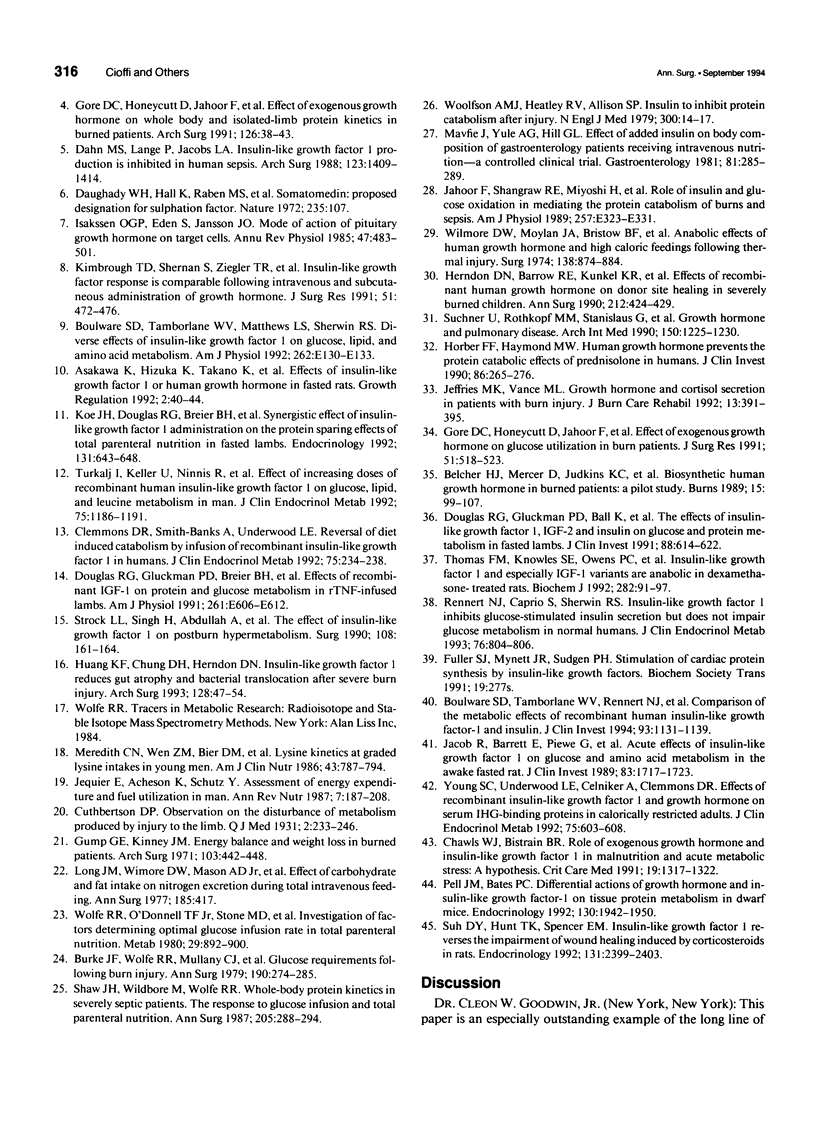
Selected References
These references are in PubMed. This may not be the complete list of references from this article.
- Asakawa K., Hizuka N., Takano K., Horikawa R., Sukegawa I., Demura H., Shizume K. Effects of insulin-like growth factor I or human growth hormone in fasted rats. Growth Regul. 1992 Mar;2(1):40–44. [PubMed] [Google Scholar]
- Belcher H. J., Mercer D., Judkins K. C., Shalaby S., Wise S., Marks V., Tanner N. S. Biosynthetic human growth hormone in burned patients: a pilot study. Burns. 1989 Apr;15(2):99–107. doi: 10.1016/0305-4179(89)90138-1. [DOI] [PubMed] [Google Scholar]
- Boulware S. D., Tamborlane W. V., Rennert N. J., Gesundheit N., Sherwin R. S. Comparison of the metabolic effects of recombinant human insulin-like growth factor-I and insulin. Dose-response relationships in healthy young and middle-aged adults. J Clin Invest. 1994 Mar;93(3):1131–1139. doi: 10.1172/JCI117065. [DOI] [PMC free article] [PubMed] [Google Scholar]
- Burke J. F., Wolfe R. R., Mullany C. J., Mathews D. E., Bier D. M. Glucose requirements following burn injury. Parameters of optimal glucose infusion and possible hepatic and respiratory abnormalities following excessive glucose intake. Ann Surg. 1979 Sep;190(3):274–285. doi: 10.1097/00000658-197909000-00002. [DOI] [PMC free article] [PubMed] [Google Scholar]
- Chwals W. J., Bistrian B. R. Role of exogenous growth hormone and insulin-like growth factor I in malnutrition and acute metabolic stress: a hypothesis. Crit Care Med. 1991 Oct;19(10):1317–1322. doi: 10.1097/00003246-199110000-00015. [DOI] [PubMed] [Google Scholar]
- Clemmons D. R., Smith-Banks A., Underwood L. E. Reversal of diet-induced catabolism by infusion of recombinant insulin-like growth factor-I in humans. J Clin Endocrinol Metab. 1992 Jul;75(1):234–238. doi: 10.1210/jcem.75.1.1619015. [DOI] [PubMed] [Google Scholar]
- Dahn M. S., Lange M. P., Jacobs L. A. Insulinlike growth factor 1 production is inhibited in human sepsis. Arch Surg. 1988 Nov;123(11):1409–1414. doi: 10.1001/archsurg.1988.01400350123019. [DOI] [PubMed] [Google Scholar]
- Daughaday W. H., Hall K., Raben M. S., Salmon W. D., Jr, van den Brande J. L., van Wyk J. J. Somatomedin: proposed designation for sulphation factor. Nature. 1972 Jan 14;235(5333):107–107. doi: 10.1038/235107a0. [DOI] [PubMed] [Google Scholar]
- Douglas R. G., Gluckman P. D., Ball K., Breier B., Shaw J. H. The effects of infusion of insulinlike growth factor (IGF) I, IGF-II, and insulin on glucose and protein metabolism in fasted lambs. J Clin Invest. 1991 Aug;88(2):614–622. doi: 10.1172/JCI115346. [DOI] [PMC free article] [PubMed] [Google Scholar]
- Douglas R. G., Gluckman P. D., Breier B. H., McCall J. L., Parry B., Shaw J. H. Effects of recombinant IGF-I on protein and glucose metabolism in rTNF-infused lambs. Am J Physiol. 1991 Nov;261(5 Pt 1):E606–E612. doi: 10.1152/ajpendo.1991.261.5.E606. [DOI] [PubMed] [Google Scholar]
- Fuller S. J., Mynett J. R., Sugden P. H. Stimulation of cardiac protein synthesis by insulin-like growth factors. Biochem Soc Trans. 1991 Aug;19(3):277S–277S. doi: 10.1042/bst019277s. [DOI] [PubMed] [Google Scholar]
- Gore D. C., Honeycutt D., Jahoor F., Rutan T., Wolfe R. R., Herndon D. N. Effect of exogenous growth hormone on glucose utilization in burn patients. J Surg Res. 1991 Dec;51(6):518–523. doi: 10.1016/0022-4804(91)90175-l. [DOI] [PubMed] [Google Scholar]
- Gore D. C., Honeycutt D., Jahoor F., Wolfe R. R., Herndon D. N. Effect of exogenous growth hormone on whole-body and isolated-limb protein kinetics in burned patients. Arch Surg. 1991 Jan;126(1):38–43. doi: 10.1001/archsurg.1991.01410250042006. [DOI] [PubMed] [Google Scholar]
- Gump F. E., Kinney J. M. Energy balance and weight loss in burned patients. Arch Surg. 1971 Oct;103(4):442–448. doi: 10.1001/archsurg.1971.01350100036007. [DOI] [PubMed] [Google Scholar]
- Herndon D. N., Barrow R. E., Kunkel K. R., Broemeling L., Rutan R. L. Effects of recombinant human growth hormone on donor-site healing in severely burned children. Ann Surg. 1990 Oct;212(4):424–431. doi: 10.1097/00000658-199010000-00005. [DOI] [PMC free article] [PubMed] [Google Scholar]
- Horber F. F., Haymond M. W. Human growth hormone prevents the protein catabolic side effects of prednisone in humans. J Clin Invest. 1990 Jul;86(1):265–272. doi: 10.1172/JCI114694. [DOI] [PMC free article] [PubMed] [Google Scholar]
- Huang K. F., Chung D. H., Herndon D. N. Insulinlike growth factor 1 (IGF-1) reduces gut atrophy and bacterial translocation after severe burn injury. Arch Surg. 1993 Jan;128(1):47–54. doi: 10.1001/archsurg.1993.01420130051009. [DOI] [PubMed] [Google Scholar]
- Isaksson O. G., Edén S., Jansson J. O. Mode of action of pituitary growth hormone on target cells. Annu Rev Physiol. 1985;47:483–499. doi: 10.1146/annurev.ph.47.030185.002411. [DOI] [PubMed] [Google Scholar]
- Jacob R., Barrett E., Plewe G., Fagin K. D., Sherwin R. S. Acute effects of insulin-like growth factor I on glucose and amino acid metabolism in the awake fasted rat. Comparison with insulin. J Clin Invest. 1989 May;83(5):1717–1723. doi: 10.1172/JCI114072. [DOI] [PMC free article] [PubMed] [Google Scholar]
- Jahoor F., Shangraw R. E., Miyoshi H., Wallfish H., Herndon D. N., Wolfe R. R. Role of insulin and glucose oxidation in mediating the protein catabolism of burns and sepsis. Am J Physiol. 1989 Sep;257(3 Pt 1):E323–E331. doi: 10.1152/ajpendo.1989.257.3.E323. [DOI] [PubMed] [Google Scholar]
- Jeffries M. K., Vance M. L. Growth hormone and cortisol secretion in patients with burn injury. J Burn Care Rehabil. 1992 Jul-Aug;13(4):391–395. doi: 10.1097/00004630-199207000-00001. [DOI] [PubMed] [Google Scholar]
- Jéquier E., Acheson K., Schutz Y. Assessment of energy expenditure and fuel utilization in man. Annu Rev Nutr. 1987;7:187–208. doi: 10.1146/annurev.nu.07.070187.001155. [DOI] [PubMed] [Google Scholar]
- Kimbrough T. D., Shernan S., Ziegler T. R., Scheltinga M., Wilmore D. W. Insulin-like growth factor-I response is comparable following intravenous and subcutaneous administration of growth hormone. J Surg Res. 1991 Dec;51(6):472–476. doi: 10.1016/0022-4804(91)90167-k. [DOI] [PubMed] [Google Scholar]
- Koea J. B., Douglas R. G., Breier B. H., Shaw J. H., Gluckman P. D. Synergistic effect of insulin-like growth factor-I administration on the protein-sparing effects of total parenteral nutrition in fasted lambs. Endocrinology. 1992 Aug;131(2):643–648. doi: 10.1210/endo.131.2.1639012. [DOI] [PubMed] [Google Scholar]
- Long J. M., 3rd, Wilmore D. W., Mason A. D., Jr, Pruitt B. A., Jr Effect of carbohydrate and fat intake on nitrogen excretion during total intravenous feeding. Ann Surg. 1977 Apr;185(4):417–422. doi: 10.1097/00000658-197704000-00008. [DOI] [PMC free article] [PubMed] [Google Scholar]
- MacFie J., Yule A. G., Hill G. L. Effect of added insulin on body composition of gastroenterologic patients receiving intravenous nutrition--a controlled clinical trial. Gastroenterology. 1981 Aug;81(2):285–289. [PubMed] [Google Scholar]
- Meredith C. N., Wen Z. M., Bier D. M., Matthews D. E., Young V. R. Lysine kinetics at graded lysine intakes in young men. Am J Clin Nutr. 1986 May;43(5):787–794. doi: 10.1093/ajcn/43.5.787. [DOI] [PubMed] [Google Scholar]
- Pell J. M., Bates P. C. Differential actions of growth hormone and insulin-like growth factor-I on tissue protein metabolism in dwarf mice. Endocrinology. 1992 Apr;130(4):1942–1950. doi: 10.1210/endo.130.4.1547721. [DOI] [PubMed] [Google Scholar]
- Rennert N. J., Caprio S., Sherwin R. S. Insulin-like growth factor I inhibits glucose-stimulated insulin secretion but does not impair glucose metabolism in normal humans. J Clin Endocrinol Metab. 1993 Mar;76(3):804–806. doi: 10.1210/jcem.76.3.8445040. [DOI] [PubMed] [Google Scholar]
- Shaw J. H., Wildbore M., Wolfe R. R. Whole body protein kinetics in severely septic patients. The response to glucose infusion and total parenteral nutrition. Ann Surg. 1987 Mar;205(3):288–294. doi: 10.1097/00000658-198703000-00012. [DOI] [PMC free article] [PubMed] [Google Scholar]
- Strock L. L., Singh H., Abdullah A., Miller J. A., Herndon D. N. The effect of insulin-like growth factor I on postburn hypermetabolism. Surgery. 1990 Aug;108(2):161–164. [PubMed] [Google Scholar]
- Suchner U., Rothkopf M. M., Stanislaus G., Elwyn D. H., Kvetan V., Askanazi J. Growth hormone and pulmonary disease. Metabolic effects in patients receiving parenteral nutrition. Arch Intern Med. 1990 Jun;150(6):1225–1230. [PubMed] [Google Scholar]
- Suh D. Y., Hunt T. K., Spencer E. M. Insulin-like growth factor-I reverses the impairment of wound healing induced by corticosteroids in rats. Endocrinology. 1992 Nov;131(5):2399–2403. doi: 10.1210/endo.131.5.1425438. [DOI] [PubMed] [Google Scholar]
- Tomas F. M., Knowles S. E., Owens P. C., Chandler C. S., Francis G. L., Read L. C., Ballard F. J. Insulin-like growth factor-I (IGF-I) and especially IGF-I variants are anabolic in dexamethasone-treated rats. Biochem J. 1992 Feb 15;282(Pt 1):91–97. doi: 10.1042/bj2820091. [DOI] [PMC free article] [PubMed] [Google Scholar]
- Turkalj I., Keller U., Ninnis R., Vosmeer S., Stauffacher W. Effect of increasing doses of recombinant human insulin-like growth factor-I on glucose, lipid, and leucine metabolism in man. J Clin Endocrinol Metab. 1992 Nov;75(5):1186–1191. doi: 10.1210/jcem.75.5.1430077. [DOI] [PubMed] [Google Scholar]
- Ward H. C., Halliday D., Sim A. J. Protein and energy metabolism with biosynthetic human growth hormone after gastrointestinal surgery. Ann Surg. 1987 Jul;206(1):56–61. doi: 10.1097/00000658-198707000-00009. [DOI] [PMC free article] [PubMed] [Google Scholar]
- Wilmore D. W., Moylan J. A., Jr, Bristow B. F., Mason A. D., Jr, Pruitt B. A., Jr Anabolic effects of human growth hormone and high caloric feedings following thermal injury. Surg Gynecol Obstet. 1974 Jun;138(6):875–884. [PubMed] [Google Scholar]
- Wolfe R. R., O'Donnell T. F., Jr, Stone M. D., Richmand D. A., Burke J. F. Investigation of factors determining the optimal glucose infusion rate in total parenteral nutrition. Metabolism. 1980 Sep;29(9):892–900. doi: 10.1016/0026-0495(80)90130-4. [DOI] [PubMed] [Google Scholar]
- Woolfson A. M., Heatley R. V., Allison S. P. Insulin to inhibit protein catabolism after injury. N Engl J Med. 1979 Jan 4;300(1):14–17. doi: 10.1056/NEJM197901043000104. [DOI] [PubMed] [Google Scholar]
- Yarasheski K. E., Zachweija J. J., Angelopoulos T. J., Bier D. M. Short-term growth hormone treatment does not increase muscle protein synthesis in experienced weight lifters. J Appl Physiol (1985) 1993 Jun;74(6):3073–3076. doi: 10.1152/jappl.1993.74.6.3073. [DOI] [PubMed] [Google Scholar]
- Young S. C., Underwood L. E., Celniker A., Clemmons D. R. Effects of recombinant insulin-like growth factor-I (IGF-I) and growth hormone on serum IGF-binding proteins in calorically restricted adults. J Clin Endocrinol Metab. 1992 Aug;75(2):603–608. doi: 10.1210/jcem.75.2.1379258. [DOI] [PubMed] [Google Scholar]
- Ziegler T. R., Young L. S., Manson J. M., Wilmore D. W. Metabolic effects of recombinant human growth hormone in patients receiving parenteral nutrition. Ann Surg. 1988 Jul;208(1):6–16. doi: 10.1097/00000658-198807000-00002. [DOI] [PMC free article] [PubMed] [Google Scholar]


